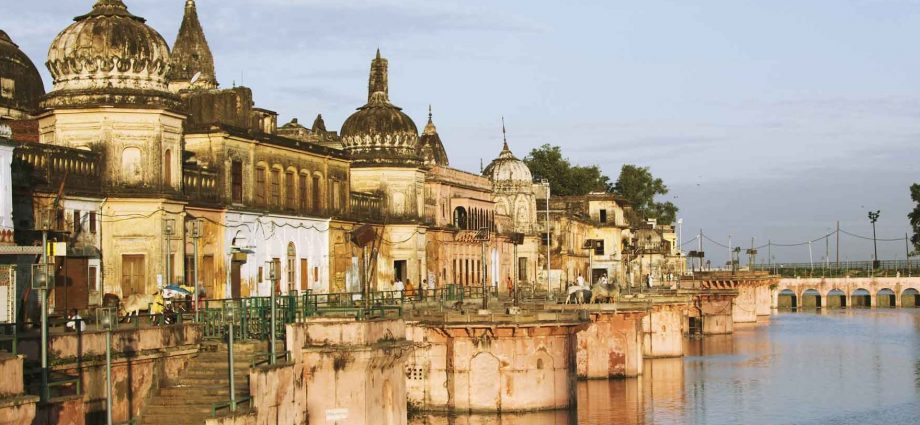Explicit description of Ayodhya in scriptures like Valmiki Ramayana, Mahabharata, Skanda Purana is available for reference. In these scriptures it has been described that in ancient time, Ayodhya was a robust, prosperous city located at the bank of the River Sarayu & it was this city where Bhagwan Shree Ram was born. In Skanda Purana, there is a clear indication of a Ram Temple in Ayodhya. During the British Period, the reference of the city of Ayodhya could be found in the books by Channing Arnold, J. Talboys Wheeler, Ralph T.H. Griffith from where the location of ancient Ayodhya could be identified as the present day Ayodhya at the bank of Sarayu River. In Babarvani by Guru Nanak, Ayodhya has been described as the city of ‘Shree Ramchandra Ji’.
The city of Ayodhya was mentioned in the writings of Al-Biruni in 1030. Apart from that, Parsian sources like Abu-Al-Fazal’s Ain-I-Akbari of 1598 also speaks eloquently about Ayodhya & mentions Ayodhya to be situated at a distance of 40 Kos to the East & 20 to the North (most probably from Agra). It has also been portrayed by Abu-Al-Fazal to be one of the largest Cities of India & situated at longitude 118,6’ & latitude 27,22’. Ayodhya was described to be the residence of Ramchandra. (Abu-Al-Fazal’s Ain-I-Akbari, English Translation, Vol. III, P 182). However, Ain-I-Akbari of Abu-Al-Fazal didn’t mention the existence of any mosque in Ayodhya.
According to some sources, Baburnama (Chronicles of Babur) did not mention either the mosque or the destruction of a temple in Ayodhya. However, A S Beveridge translated Baburnama in English in 4 volumes much later in between 1912 & 1922. Beveridge collected documents from both Parsian & Turki sources where she mentioned that Babur felt mesmerized by the beauty & auspicious rituals of an existing Hindu Temple at Ayodhya and, as an obedient follower of Prophet Mahammad, felt it to be his pious duty to replace that temple with a mosque. Another document, closely contemporary to Ain-I-Akbari, Ramcharit Manas by Tulsidas (1574) also made no mention of any mosque in Ayodhya.
William Finch, a British traveller visited Ayodhya in around 1611. Finch wrote about the “ruins of the Ranichand [Ramachand] castle and houses” where Hindus believed the great God “took flesh upon him to see the tamasha of the world.” Finch described Brahmin priests were keeping records of the names of pilgrims in the ruins of the fort. However, there was no mention of the presence of any mosque there.
British Historian Thomas Herbert described in 1634 a “pretty old castle of Ranichand” which he described as an “antique monument” that was “especially memorable“. He didn’t mention existence of any mosque. Herbert too noted the fact that Brahmins kept records of pilgrims.
Amongst the Urdu sources, Lakshminarayan Sadar Kanungo, assisted by Munshi Hashim, Lucknow, in 1923, provided a detailed account of the replacement of the temple by the mosque. Muhammad Najmu, in his Tarikh-i-Awadh, 1919, Vol. V says “at Ayodhya, where there stood the temple of Ramchandra Ji’s janmasthan, there is Sita Ji ki Rasoi adjacent to it, King Babur got a magnificent mosque built there.” Apart from these, writings of Sayyid Kamal-ud-din Hayder in 1896, Nizamiddin Dawlah in 1876 etc all referred to Ayodhya, Ram Temple & Mosque constructed on the same site.
Amongst the British Government Records, Montgomery Martin, British Surveyor in his “History Antiquities Topography & Statistics of Eastern India” Vol II, 1838, page 335-336, Edward Thornton, a Gazetteer of the Territories under the Government of the East India Company, Vol. IV, 1854, page 739-740, Surgeon General Edward Balfour in his “Encyclopedia of India & of Eastern & Southern Asia”, 1858, page 56, P Carnegy, in his “A Historical Sketch of Tehsil Fyzabad, with the Old Capitals Ajudhia & Fyzabad”, 1870 page 5-7, A. F. Mettell in his “Report of the Settlement of the Land Revenue Fyzabad District”, 1880, page 216-217, 234-235, 238 & several such other sources categorically mentioned that Babur built the mosque at the site then occupied by a fine temple in the janmasthan.
However, again, Joseph Tieffenthaler, an European Jesuit missionary who lived and worked in India for 38 years (1743–1785) and wrote numerous documents about India, jotted down in his Latin Travelogue “Historique et Geographique de L’Inde” (French translation by Jean Barnoulli in 1786) while he toured in Avadh during 1766-71— “But a spot particularly famous is known as Sita Rasoi, i.e. table of Sita, Ram’s wife…Emperor Aurangzeb demolished the fortress called Ramkot & got erected a Muslim Temple with three domes on the same place. Others say that it was constructed by Babur. Fourteen pillars of Blackstone, five spans high, are located in the fortress; twelve of these pillars are in the interior arch of the mosque; 2 out of 12 are at the door of the cloister. The other two are in the tomb of an unknown Maure(Muslim)…on the left, one can see a square box raised 5 inches above the Earth… Hindus call it Bedi i.e. the cradle because formerly it was the house where Beschan & his three brothers were born under the form of Ram…In his slight, Aurangzeb or according to some, Babur destroyed this place in order to prevent Hindus from performing their rituals on this place. However, they still perform their rituals at another place which is the birth place of Ram by rounding it three times and then prostrating flat on the ground.” The author obviously refers to Ramnavami festival when he adds, “on 24th of Chaitra, a large number of people gather here to celebrate the birth of Ram extremely popular throughout India.”
Regression & compilation of all such documents & innumerable others across historical timeline support the fact that Ayodhya was a place of interest as the birthplace of Lord Ram. These documents also indicate existence of a long-term conflict between Hindus & Muslims regarding the claim of a particular place at Ayodhya though the exact time of inception of the conflict is not confirmed.

